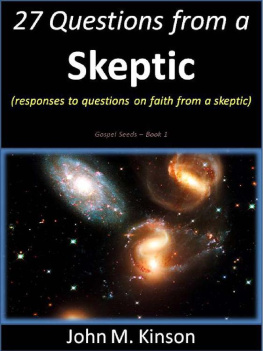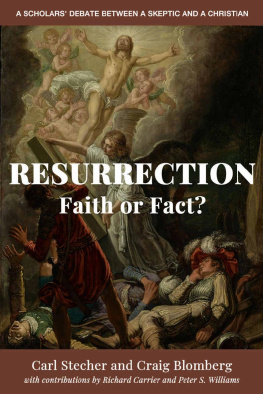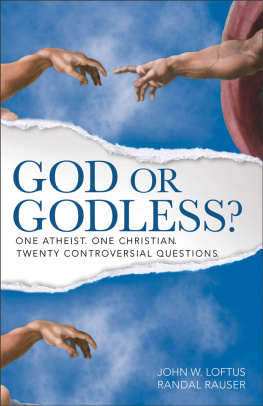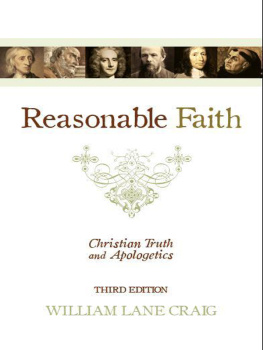Book Description
This book presents 27 hard-hitting questions (on Christian Faith) from askeptic, together with respectful and reasoned responses from an ex-atheistChristian.
Most of these are questions that the author himself hadduring his search for ultimate truth, when he was looking into the existence(or non-existence) of God, and the truth (or falsehood) of Christianity. Overtime, he came to realize that there are reasonable (and rational) answers tohis questions. This helped him to come to the intellectual conviction thatChristian Theism (belief in the Christian God) is reasonable and rational.Ultimately, this helped him to commit his life to Christ.
This book includes questions on (a) Jesus sacrifice onthe cross, (b) the size of the universe, (c) Gods slowness, (d) slowness ofthe gospel, (e) origin of the Christian notion of God, (f) the Trinity, (g)suffering, (h) miracles, (i) a mothers sorrow, (j) eternal punishment, (k) anequitable hell, (l) worship, (m) the boredom of eternal worship, (n) Bible contradictions,(o) the Bible as a first century human product of Palestine, (p) God neveranswering prayer, (q) hearsay and conjecture in the gospels, (r) the creationmyth being debunked, (s) a logical problem with omniscience, (t) a logicalproblem with a perfect God, (u) God and the flying spaghetti monster, (v) thosewho havent heard the gospel, (w) an inhospitable planet, (x) smallpox and God,(y) God approving suffering, (z) God not healing amputees, and (za) terminallyill children.
As mentioned above, there are reasonable (and rational)answers to all of these questions. This book presents the questions and answerswith this in mind.
---
About the Author:
The description below is from the book There is a God:How an Atheist Scientist Changed his Mind by John M. Kinson.
This book (There is a God) presents the questions andanswers, thoughts and discussions that occurred in the course of an AtheistScientist moving from an atheistic world-view to belief in God. Many years ofinvestigation, and an honest and rational appraisal of the scientific andphilosophical evidence led him to the conclusion that God does exist.
John (pen-name) is a research scientist with more than100 publications in the hard-sciences, more than 10 inventions (with patents invarious countries), and numerous scientific and technical awards in the courseof his scientific career. He has collaborated with and published hard-scienceresearch articles with scientists from many of the top research universities inthe world.
In this book (There is a God), he presents a briefhistory of his journey (intellectually speaking) from Atheism to Theism andultimately to Christ.
The book is not intended to be a rigorous defense ofTheism, nor is it intended to be a rigorous defense of Christianity, but ratherthe path taken intellectually by one Atheist Scientist to a Theistic Worldview,and ultimately to a commitment to Christ.
---
For more information:
The description below is from the book Does SciencePoint to God? Is there Scientific Evidence for God? by John M. Kinson.
This book (Does Science Point to God?) is the resultof a search by John (an atheist scientist) for ultimate truth. He went throughseveral years of intense questioning of the meaning of life, and of the natureof ultimate reality.
Over a period of time he investigated areas such as
Isthere evidence for God?
Isthere Scientific Evidence for God?
Isit Rational to believe in God?
Isit Reasonable to believe in God?
This book (Does Science Point to God?) briefly discussessome of the scientific and philosophical evidence that he came across duringhis investigation.
In particular, this book (Does Science Point to God?)discusses (a) the origin of the universe, (b) the fine-tuning of the universe,(c) the origin of first life, and (d) the presence of language and informationin DNA, in the context of Scientific Evidence for God.
COPYRIGHTPAGE
Copyright 2015
by John M. Kinson
All rights reserved.
No part of this publication may be reproduced in any form without prior writtenpermission from the copyright owner. And, no part of this publication may bestored in a retrieval system, or transmitted in any form, or by any means(electronic, paper, photocopies, printed copies, recordings or other) withoutthe prior written permission of the copyright owner.
Cover-image Credit:
NASA,ESA and the Hubble SM4 ERO Team
TABLE OF CONTENTS
Acknowledgements
Iam grateful to the various individuals (Joanna, Audrey, Samantha, Chandra, Uma,Bart, Dan, Ko, Mike, Donald, Jack and many others) whose interest,encouragement and constructive criticism have influenced my thoughts and writing(and my answering of questions from seekers and skeptics, both in this book andelsewhere).
Cover Image
About theCover-Image of this book:
Galacticwreckage in Stephan's Quintet
A clash amongmembers of a famous galaxy quintet reveals an assortment of stars across a widecolor range, from young, blue stars to aging, red stars.
This portrait ofStephan's Quintet, also known as the Hickson Compact Group 92, was taken by thenew Wide Field Camera 3 (WFC3) aboard the NASA/ESA Hubble Space Telescope.Stephan's Quintet, as the name implies, is a group of five galaxies. The name,however, is a bit of a misnomer. Studies have shown that group member NGC 7320,at upper left, is actually a foreground galaxy that is about seven times closerto Earth than the rest of the group.
Three of thegalaxies have distorted shapes, elongated spiral arms, and long, gaseous tidaltails containing myriad star clusters, proof of their close encounters. Theseinteractions have sparked a frenzy of star birth in the central pair ofgalaxies. This drama is being played out against a rich backdrop of farawaygalaxies.
The image, taken invisible and near-infrared light, showcases WFC3's broad wavelength range. Thecolors trace the ages of the stellar populations, showing that star birthoccurred at different epochs, stretching over hundreds of millions of years.The camera's infrared vision also peers through curtains of dust to seegroupings of stars that cannot be seen in visible light.
NGC 7319, at topright, is a barred spiral with distinct spiral arms that follow nearly 180degrees back to the bar. The blue specks in the spiral arm at the top of NGC7319 and the red dots just above and to the right of the core are clusters ofmany thousands of stars. Most of the Quintet is too far away even for Hubble toresolve individual stars.
Continuingclockwise, the next galaxy appears to have two cores, but it is actually twogalaxies, NGC 7318A and NGC 7318B. Encircling the galaxies are young, brightblue star clusters and pinkish clouds of glowing hydrogen where infant starsare being born. These stars are less than 10 million years old and have not yetblown away their natal cloud. Far away from the galaxies, at right, is a patchof intergalactic space where many star clusters are forming.
NGC 7317, at bottomleft, is a normal-looking elliptical galaxy that is less affected by theinteractions.
Sharply contrastingwith these galaxies is the dwarf galaxy NGC 7320 at upper left. Bursts of starformation are occurring in the galaxy's disc, as seen by the blue and pinkdots. In this galaxy, Hubble can resolve individual stars, evidence that NGC7320 is closer to Earth. NGC 7320 is 40 million light-years from Earth. Theother members of the Quintet reside about 300 million light-years away in theconstellation Pegasus.











